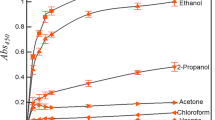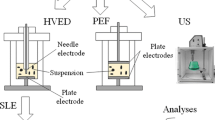Abstract
The purpose of this research was to study whether pulsed electric fields (PEFs) could reduce variability in the activity and thermostability of ascorbic acid oxidase (AAO) in the purée of different carrot cultivars, i.e. Daucus carota cv. Nantes, White Belgian, Solar Yellow, Nutri Red and Purple Haze. The carrot purée was treated at different energy inputs (35 and 300 kJ/kg) and electric field strengths (0.3, 0.5 and 0.8 kV/cm). AAO catalytic kinetics was described using the Michaelis-Menten model to estimate V max and K M . The catalytic kinetics of AAO varied greatly depending on cultivar with the highest V max in White Belgian and the lowest V max in Nantes. Energy input of 300 kJ/kg significantly (p < 0.05) reduced the V max in White Belgian and Yellow Solar and increased the K M in Nantes and Nutri Red. A first-order reaction model was used to describe AAO thermal inactivation kinetics (60–70 °C) and to estimate the inactivation rate constant (k) at a reference temperature of 65 °C (k ref ) and the temperature dependency of k (E a ). AAO in Purple Haze was found to have the lowest E a and the highest k ref , while the highest E a was observed in Yellow Solar and the lowest k ref in Nantes. This study demonstrated that PEF treatment at various electric field strengths changed the thermostability of AAO. PEF treatment of 0.8 kV/cm and 35 kJ/kg reduced the variability of AAO thermostability in the purée of these different carrot cultivars and consequently narrowed the window of processing temperature and time combinations to achieve the same degree of AAO inactivation.



Similar content being viewed by others
References
Adams, J. B. (1991). Review: enzyme inactivation during heat processing of food-stuffs. International Journal of Food Science and Technology, 26(1), 1–20.
Amon, A., & Markakis, P. (1973). Properties of ascorbate oxidase isozymes. Phytochemistry, 12(9), 2127–2132.
Bazhal, M. I., Lebovka, N. I., & Vorobiev, E. (2003). Optimisation of pulsed electric field strength for electroplasmolysis of vegetable tissues. Biosystems Engineering, 86(3), 339–345.
Carbonaro, M., Mattera, M., Nicoli, S., Bergamo, P., & Cappelloni, M. (2002). Modulation of antioxidant compounds in organic vs conventional fruit (Peach, Prunus persica L., and Pear, Pyrus communis L.). Journal of Agricultural and Food Chemistry, 50(19), 5458–5462.
Carvalho, L. B., Jr., Lima, C. J., & Medeiros, P. H. (1981). Ascorbate oxidase from Cucurbita maxima. Phytochemistry, 20(10), 2423–2424.
Castro, A. J., Swanson, B. G., Barbosa-Cánovas, G. V., & Zhang, Q. H. (2001). Pulsed electric field modification of milk alkaline phosphatase activity. In G. V. Barbosa-Cánovas, Q. H. Zhang, & G. Tabilo-Munizaga (Eds.), Pulsed electric fields in food processing: fundamental aspects and applications (food preservation technology). Pennsylvania: Technomic Publishing Company.
Catalano, A. E., Ingallinera, B., Todaro, A., Rapisarda, P., & Spagna, G. (2009). Degradative enzymatic activities in fresh-cut blood-orange slices during chilled-storage. International Journal of Food Science and Technology, 44(5), 1041–1049.
Di Venere, A., Nicolai, E., Rosato, N., Rossi, A., Finazzi Agrò, A., & Mei, G. (2011). Characterization of monomeric substrates of ascorbate oxidase. FEBS Journal, 278(9), 1585–1593.
Elez-Martínez, P., Aguiló-Aguayo, I., & Martín-Belloso, O. (2006). Inactivation of orange juice peroxidase by high-intensity pulsed electric fields as influenced by process parameters. Journal of the Science of Food and Agriculture, 86(1), 71–81.
Elez-Martínez, P., Suárez-Recio, M., & Martín-Belloso, O. (2007). Modeling the reduction of pectin methyl esterase activity in orange juice by high intensity pulsed electric fields. Journal of Food Engineering, 78(1), 184–193.
Giner, J., Gimeno, V., Espachs, A., Elez, P., Barbosa-Cánovas, G. V., & Martı́n, O. (2000). Inhibition of tomato (Licopersicon esculentum Mill.) pectin methylesterase by pulsed electric fields. Innovative Food Science and Emerging Technologies, 1(1), 57–67.
Giner, J., Gimeno, V., Barbosa-Cánovas, G. V., & Martín, O. (2001). Effects of pulsed electric field processing on apple and pear polyphenoloxidases. Food Science and Technology International, 7(4), 339–345.
Giner, J., Ortega, M., Mesegué, M., Gimeno, V., Barbosa-Cánovas, G. V., & Martín, O. (2002). Inactivation of peach polyphenoloxidase by exposure to pulsed electric fields. Journal of Food Science, 67(4), 1467–1472.
Grattan, S. R., & Grieve, C. M. (1998). Salinity–mineral nutrient relations in horticultural crops. Scientia Horticulturae, 78(1–4), 127–157.
Hallaway, M., Phethean, P. D., & Taggart, J. (1970). A critical study of the intracellular distribution of ascorbate oxidase and a comparison of the kinetics of the soluble and cell-wall enzyme. Phytochemistry, 9(5), 935–944.
Holdsworth, S. D., & Simpson, R. (2007). Sterilization, pasteurization and cooking criteria. In S. D. Holdsworth & R. Simpson (Eds.), Thermal processing of packaged foods (pp. 123–141). Food Engineering Series): Springer US.
Houben, K., Kermani, Z. J., Van Buggenhout, S., Jolie, R. P., Van Loey, A. M., & Hendrickx, M. E. (2013a). Thermal and high-pressure stability of pectinmethylesterase, polygalacturonase, β-galactosidase and α-arabinofuranosidase in a tomato matrix: towards the creation of specific endogenous enzyme populations through processing. Food and Bioprocess Technology, 6(12), 3368–3380.
Houben, K., Kermani, Z. J., Van Buggenhout, S., Van Loey, A. M., & Hendrickx, M. E. (2013b). Thermal and high-pressure stability of pectin-converting enzymes in broccoli and carrot purée: towards the creation of specific endogenous enzyme populations through processing. Food and Bioprocess Technology, 52, 1–12.
Kim, Y. R., Yu, S. W., Lee, S. R., Hwang, Y. T., & Kang, S. O. (1996). A heme-containing ascorbate oxidase from Pleurotus ostreatus. Journal of Biological Chemistry, 271(6), 3105–3111.
Lebovka, N. I., Bazhal, M. I., & Vorobiev, E. (2002). Estimation of characteristic damage time of food materials in pulsed-electric fields. Journal of Food Engineering, 54(4), 337–346.
Lee, S. R., Joo, W. J., Baek, Y. U., Lee, Y. K., Yu, S. W., Kim, Y. R., et al. (2009). Intracellular substrates of a heme-containing ascorbate oxidase in Pleurotus ostreatus. The Journal of Microbiology, 47(2), 178–186.
Leong, S. Y., & Oey, I. (2012). Effect of endogenous ascorbic acid oxidase activity and stability on vitamin C in carrots (Daucus carota subsp. sativus) during thermal treatment. Food Chemistry, 134(4), 2075–2085.
Leong, S. Y., & Oey, I. (2014). Effect of pulsed electric field treatment on enzyme kinetics and thermostability of endogenous ascorbic acid oxidase in carrots (Daucus carota cv. Nantes). Food Chemistry, 146C, 538–547.
Maccarrone, M., D'Andrea, G., Salucci, M. L., Avigliano, L., & Finazzi-Agrò, A. (1993). Temperature, pH and UV irradiation effects on ascorbate oxidase. Phytochemistry, 32(4), 795–798.
Min, S., Min, S. K., & Zhang, Q. H. (2003). Inactivation kinetics of tomato juice lipoxygenase by pulsed electric fields. Journal of Food Science, 68(6), 1995–2001.
Morris, H. J., Weast, C. A., & Lineweaver, H. (1946). Seasonal variation in the enzyme content of eleven varieties of carrots. Botanical Gazette, 107(3), 362–372.
Mosery, O., & Kanellis, A. K. (1994). Ascorbate oxidase of Cucumis melo L. var. reticulatus: purification, characterization and antibody production. Journal of Experimental Botany, 45(6), 717–724.
Munyaka, A. W., Makule, E. E., Oey, I., Van Loey, A. M., & Hendrickx, M. E. (2010). Thermal stability of L-ascorbic acid and ascorbic acid oxidase in broccoli (Brassica oleracea var. italica). Journal of Food Science, 75(4), C336–C340.
Nicolai, E., Di Venere, A., Rosato, N., Rossi, A., Finazzi Agro, A., & Mei, G. (2006). Physico-chemical properties of molten dimer ascorbate oxidase. FEBS Journal, 273(22), 5194–5204.
Porto, T. S., Porto, C. S., Cavalcanti, M. T. H., Filho, J. L. L., Perego, P., Porto, A. L. F., et al. (2006). Kinetic and thermodynamic investigation on ascorbate oxidase activity and stability of a Cucurbita maxima extract. Biotechnology Progress, 22(6), 1637–1642.
Raseetha, S., Leong, S. Y., Burritt, D. J., & Oey, I. (2013). Understanding the degradation of ascorbic acid and glutathione in relation to the levels of oxidative stress biomarkers in broccoli (Brassica oleracea L. italica cv. Bellstar) during storage and mechanical processing. Food Chemistry, 138(2–3), 1360–1369.
Rayan, A. M. M., Gab-Alla, A. A., Shatta, A. A., & El-Shamei, Z. A. S. (2011). Thermal inactivation kinetics of quality-related enzymes in cauliflower (Brassica oleracea var. botrytis). European Food Research and Technology, 232(2), 319–326.
Riener, J., Noci, F., Cronin, D. A., Morgan, D. J., & Lyng, J. G. (2008). Combined effect of temperature and pulsed electric fields on soya milk lipoxygenase inactivation. European Food Research and Technology, 227(5), 1461–1465.
Riener, J., Noci, F., Cronin, D. A., Morgan, D. J., & Lyng, J. G. (2009). Effect of high intensity pulsed electric fields on enzymes and vitamins in bovine raw milk. International Journal of Dairy Technology, 62(1), 1–6.
Saari, N., Fujita, S., Miyazoe, R., & Okugawa, M. (1995). Distribution of ascorbate oxidase activities in the fruits of family Cucurbitaceae and some of their properties. Journal of Food Biochemistry, 19(4), 321–327.
Saari, N., Fujita, S., Yamaguchi, S., & Tono, T. (1996). Distribution of ascorbate oxidase in citrus fruits. Food Science and Technology International, Tokyo, 2(3), 154–156.
Saari, N., Osman, A., Selamat, J., & Fujita, S. (1999). Ascorbate oxidase from starfruit (Averrhoa carambola): preparation and its application in the determination of ascorbic acid from fruit juices. Food Chemistry, 66(1), 57–61.
Sampedro, F., Geveke, D. J., Fan, X. T., & Zhang, H. Q. (2009). Effect of PEF, HHP and thermal treatment on PME inactivation and volatile compounds concentration of an orange juice–milk based beverage. Innovative Food Science and Emerging Technologies, 10(4), 463–469.
Schilling, S., Schmid, S., Jäger, H., Ludwig, M., Dietrich, H., Toepfl, S., et al. (2008). Comparative study of pulsed electric field and thermal processing of apple juice with particular consideration of juice quality and enzyme deactivation. Journal of Agricultural and Food Chemistry, 56(12), 4545–4554.
Shimada, Y., & Ko, S. (2008). Ascorbic acid and ascorbic acid oxidase in vegetables. Chugokugakuen Journal, 7, 7–10.
Stevanato, R., Avigliano, L., Finazzi-Agrò, A., & Rigo, A. (1985). Determination of ascorbic acid with immobilized green zucchini ascorbate oxidase. Analytical Biochemistry, 149(2), 537–542.
Van Assche, F., & Clijsters, H. (1990). Effects of metals on enzyme activity in plants. Plant, Cell & Environment, 13(3), 195–206.
Van Loey Indrawati, A. M., Ludikhuyze, L. R., & Hendrickx, M. E. (1999). Single, combined, or sequential action of pressure and temperature on lipoxygenase in green beans (Phaseolus vulgaris L.): a kinetic inactivation study. Biotechnology Progress, 15(2), 273–277.
Van Loey, A. M., Smout Indrawati, C., & Hendrickx, M. E. (2002a). Inactivation of enzymes: from experimental design to kinetic modeling. In J. R. Whitaker, A. G. J. Voragen, & D. W. S. Wong (Eds.), Handbook of food enzymology (pp. 49–58). New York: CRC Press.
Van Loey, A. M., Verachtert, B., & Hendrickx, M. E. (2002b). Effects of high electric field pulses on enzymes. Trends in Food Science and Technology, 12(3–4), 94–102.
Wawire, M., Oey, I., Mathooko, F., Njoroge, C., Shitanda, D., & Hendrickx, M. E. (2011). Thermal stability of ascorbic acid and ascorbic acid oxidase in African cowpea leaves (Vigna unguiculata) of different maturities. Journal of Agricultural and Food Chemistry, 59(5), 1774–1783.
Yahia, E. M., Contreras-Padilla, M., & Gonzalez-Aguilar, G. (2001). Ascorbic acid content in relation to ascorbic acid oxidase activity and polyamine content in tomato and bell pepper fruits during development, maturation and senescence. LWT - Food Science and Technology, 34(7), 452–457.
Yeom, H. W., Zhang, Q. H., & Chism, G. W. (2002). Inactivation of pectin methyl esterase in orange juice by pulsed electric fields. Journal of Food Science, 67(6), 2154–2159.
Zhang, Q. H., Barbosa-Cánovas, G. V., & Swanson, B. G. (1995). Engineering aspects of pulsed electric field pasteurization. Journal of Food Engineering, 25(2), 261–281.
Zhao, W., Yang, R. J., & Zhang, H. Q. (2012). Recent advances in the action of pulsed electric fields on enzymes and food component proteins. Trends in Food Science and Technology, 27(2), 83–96.
Acknowledgment
Sze Ying Leong acknowledges University of Otago (UO) Doctoral Scholarship towards her PhD study. We also thank Susan Mackenzie (Botany, UO) for taking care of the carrots during their cultivation in the glasshouse. Authors are grateful to Jo’ann Ayers (Food Science, UO) for proof-reading the manuscript.
Author information
Authors and Affiliations
Corresponding author
Rights and permissions
About this article
Cite this article
Leong, S.Y., Oey, I. & Burritt, D.J. A Novel Strategy Using Pulsed Electric Fields to Modify the Thermostability of Ascorbic Acid Oxidase in Different Carrot Cultivars. Food Bioprocess Technol 8, 811–823 (2015). https://doi.org/10.1007/s11947-014-1448-x
Received:
Accepted:
Published:
Issue Date:
DOI: https://doi.org/10.1007/s11947-014-1448-x




